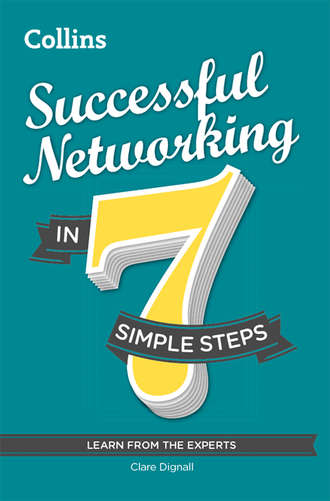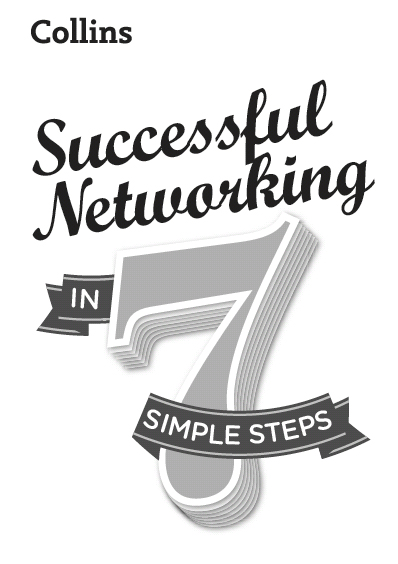
Полная версия
Successful Networking in 7 simple steps


Contents
Step 1 Creating networking opportunities
Step 2 Network effectively online
Step 3 Secure an invitation
Step 4 Be the best conversationalist
Step 5 Survive difficult moments
Step 6 Work the room
Step 7 Follow up on leads
Keep Reading
About the Author
Copyright
About the Publisher
Step 1
CREATING NETWORKING OPPORTUNITIES
‘The richest people in the world look for and build networks, everyone else looks for work.’ — Robert T. Kiyosaki, Author
Five ways to succeed
Know your reasons for networking.
Re-acquaint yourself with people you already know.
Value both close friends and acquaintances.
Give, without expecting anything in return.
Learn how to measure your networking results.
Five ways to fail
Don’t waste time networking with family.
Try to make as many new contacts as you possibly can.
Get what you want out of every meeting.
Let your networking take its own natural course.
Network as soon as you can: sort out business detail later.

Networking. Everyone talks about it. But what on earth is networking anyway? Simply put, networking is the process of meeting new people, and maintaining valuable contact with these people, to the benefit of both you and them. It’s not a special business skill, it’s a human and social aptitude that we all have. But one of the most important things that can shape your networking, is knowing what you want out of it. Take a minute to consider the following:
Am I networking in order to change career?
Do I want to start networking after a career break?
Am I networking in order to grow my own business?
Am I networking to grow the client base of the company I work for?
If you want to change career, for example, you should be attempting to ‘break out’ of your existing network to source new contacts. Conversely, if you’re growing your own business, you may want to network in a focused way within one specific target market. Whatever your approach, remember this – networking presents opportunities in unexpected places, so never be closed to a serendipitous meeting, even if it is not in your ‘game plan’.
Identifying your existing network
You may be thinking ‘How can I network if I don’t even have a network?’ Well the good news is, you do, and it probably looks something like this:
Your family: a reliable source of support, information and local knowledge.
Your friends: people you rely on for support and ideas.
Your work or study colleagues, past or present: people who know your work skills can give insights into other roles that might suit you, and possibly new vacancies.
Your acquaintances: people you meet day-to-day – your barber, mechanic, neighbour etc.
Surprisingly, it’s the people you know least that could be most useful to you. Known as ‘weak ties’, these people are at the edges of your social network, so know a different set of people who may present fresh opportunities. The trick in successful networking is to invest time in these weak ties to ensure that, should an opportunity arise, it is your name that they think of first.

Rediscovering your existing network
So, you already have a personal network in place. As yet, it may be untapped. To breathe new life into this existing network, you need do little more than set aside some time and adopt a new way of thinking. All of us are guilty to some extent of dismissing the people we know ‘Oh that’s Mike, I worked with him in IT, bit of a web geek’ and leaving them languishing in the little stereotypes we’ve dumped them in. If you’re serious about networking it’s time to look at everyone you know with fresh eyes. What are their skills you don’t you know about? What are their hobbies? What are their aspirations? Who do they work with? What do they believe are your best talents? Spend time with friends, family and colleagues you’ve not seen lately. Make an effort not to hog conversation or go over old topics. Treat them as if you’ve just met. Listen (you’ll find insights into how to do this in Step 4). You’ll be amazed at what you will unearth.
Similarly, when you’re getting a haircut or doing the school run, don’t ignore everyone because you think the people you meet at these times are not ‘important’. Engage them in conversation, allow them to talk. Listen. Hey presto – you’re networking. Networking is a way of life; it affects and underlines the value of our interactions with all human beings – you can’t just save it for the moments labelled ‘Networking Event’.
Blood may not be thicker than water
When you are building an effective and supportive network it is important to know exactly who you can rely on in a tight spot. We have all heard the old saying ‘blood is thicker than water’ and many of us assume that our strongest ties are those that are related to us through blood or marriage. But in the world of business, it is often safest to assume nothing. It can be enlightening, at regular periods, to ask yourself the following questions:
Am I happy with who is closest to me?
When we talk about the people that are ‘closest’ to us, we usually include family and long-standing friends in that list. They are the people who have known us the longest, we spend most time with, and in most instances, have partially ‘created’ the person that we are now through long years of parenting, peer interaction, schooling and socializing. We unquestioningly assume they are on our side. But are they? Time to ask yourself a tough question: ‘Am I still happy with how much my family and friends influence me?’ Perhaps you seek the approval of parents or friends a little too much? Are your peers suspicious of success? Are you staying in a job you don’t want because you feel that’s what’s expected of you? If your aim to is to change the way your life looks, you may have to work out whether there are any people, very close to you, that are limiting you.
Who would I turn to in a crisis?
It’s likely that asking yourself the first question will have revealed some unsettling home truths. By asking just one more tough question, you will find out who your real friends are. Imagine yourself in an awful situation. You’ve lost your job, your business is failing, or you’re going through a gruelling period of stress at work. Who, in reality, would you turn to? Without analysing too much, quickly write down a list of the people you would turn to first for advice and help. You may be surprised by what you see. If some of the entries on that list are people that you would never have counted as strong ties – are not family, and whom you see rarely, it may be time to sort that out. These people are clearly important to you on many levels: make it a priority to invest some time in them now. If you ever are to be faced with that worst-case scenario, you want them wholly on your side.
By asking two simple questions, you are likely to have a much clearer idea about who you want ‘on your team’. Some people are just plain good for us – they are supportive, trustworthy, positive and inspiring – in their company we aspire to greater things. Some people are not so good for us and can seriously limit what we can achieve. The trick is identifying who is who, and we’ll find out more later.

A big reason for many people beginning to network seriously is that they want ‘change’. Well, you can start the process of change, and build your confidence too, just from the people you already know.
Build bridges to other networks
One very simple way to give your network’s breadth an immediate boost is to hold your own event. Make it an ‘open house’ and ask your friends to bring a few of their friends. This is a simple way to stretch the edges of your network and open pathways to new ones. Be attentive to the new faces amongst your guests – they will remember a good listener and may end up being valuable contacts or friends.
Surround yourself with those that bring out your best
Ever noticed that you always look better in photos taken with your best friends? It doesn’t apply to just our looks; people that are ‘good’ for us bring out the best in us – our best work, ideas and attitude. If you want positive change, start spending most time with the people in your network that make you feel good. This simple tactic can have a positive effect on your outlook and self-confidence.

So, you are mining all the value of your existing network by rediscovering the people in it and making new mutual acquaintances. Now add some new faces by breaking out of your existing network entirely. But how?
Visit your library: Your local library holds information on business and social events in your area, and many of these will be free.
Business support organizations: Organizations like Business Link in England and Business Gateway in Scotland offer free and impartial advice to people in business or starting their own. Many run free workshops so you can learn new skills and meet like-minded people at the same time.
Research online: Type in the keywords of your field of interest or business and search for upcoming events. You’ll soon find something within feasible travelling distance that suits your budget.
Night classes and courses: If you are planning to change careers or are coming back to work you may need to acquire a new set of skills. Short courses refresh your CV and your network too.
Volunteering: Want to learn new skills, meet new people and on a tight budget? Find your nearest volunteering centre and ask them about opportunities.

It’s generally believed that a person can only sustain around 150 meaningful social relationships; all those people you see on Facebook with 350+ friends don’t really have 350 lifelong buddies; they’ll have a few, the rest are acquaintances.
Ensure that your growing network has ‘balance’ too. Is it made up of both strong ties (people you can rely on) and weak ties (acquaintances who may present an opportunity in the future)? If one group dominates, then it may be time to redress the balance. Reid Hoffman, Co-Founder and Chairman of LinkedIn®, makes a helpful analogy to explain this process of finding ‘balance’: you have one memory card for your digital camera on a six-month trip. Because the capacity is finite, you must choose whether you want to store a few great photos at hi-res, store hundreds at lo-res, or a mixture of both. So it is with your network – you cannot maintain all your relationships at ‘hi-res’, but a huge, ‘lo-res’ network will not provide you with the support you need when times are hard. You need a mixture of both: strong ties to help and guide you on your career journey, and weak ties to refresh your network, provide new information and offer opportunities.

You may not yet be convinced by the idea of networking. Many people still have a suspicion of networking, associating it with dishonesty and aggressive deal-making. For some misguided souls, that’s what networking is: only coming out of the office when you need something, working the event to get the introduction you want, or squeezing your new contact till you get the deal you want. Effective in the short term, but you’ll make no lasting relationships.
Contemporary approaches to networking turn this short-sighted tactic on its head. It’s all about building lasting relationships first, and, crucially, offering upfront value to your new contact in the hope that someday you may reap reward in return. This kind of networker (‘go-givers’ in networking terminology) will meet new people and attempt to see the world from their eyes, listening to their needs and aspirations. He or she will then consider whether they might be of help to the other person to fulfil those needs. Could they introduce someone useful? Do they have some information they could share? This ‘help’ just has to be timely, appropriate, and of value to the other. Establishing relationships on these grounds will gain you lifelong allies.

Now let’s check that we are ‘event-ready’ from an entirely practical perspective. You may have the best attitude in the world but to be a successful networker you will also have to prepare in other ways: what do you need to take with you? Do you need a business card? Do you really need to finish your website before you tell people about it? What practical preparations do we need to make to network at events effectively? In the coming pages we consider some useful practical preparations.

Get business cards printed
Although we live in a hi-tech, increasingly paperless age, it’s a surprising fact that the business card is still a must-have item in the world of networking. The act of exchanging them is a rite of passage in itself, a sort of low-level ‘trade and contract’ between you and the person you’ve just met. The reciprocal movement of exchange also provides a physical ice-breaker and puts the two of you on a level playing field.
If you are networking on behalf of your employer, it’s likely you already have a business card. If you don’t, you need to get some, for without business cards, all your networking efforts will be for naught. If you are starting your own business then ensure you have business cards printed before you start networking. You may think that’s a start-up expense you could do without, but it’s imperative to have some and they needn’t cost much – the web is full of sites printing business cards at very little cost. If you are hoping to switch careers, you may want to consider printing a personal business card, so that you can prevent a job offer being sent to a work email. What’s on your business card? Remember, you may need more information for use internationally than you need in your own country. And you may need information in the language of the country in which you plan to network.
Petersfield Projects

Tony Fawkes M.A. Managing Director
Petersfield Projects
6 Manor Drive, Petersfield, Sussex P03 2PZ
T 01377 201564
M 097015 400400
E tony.fawkes@petersfieldprojects.co.uk
W www.petersfieldprojects.co.uk
Check your ‘back office’
Before you finalize your business cards, ensure that everything you say on the card holds true. There is nothing more infuriating than typing in a web address from a business card and finding that the website is a work in progress, or (much worse) cannot be found. Such a faux pas will speak undesirable volumes about your organizational skills, so before you give out business cards, literally do what a new contact would do. Get someone to ring your phone number and ensure that it comes directly to you, send a test email to the address printed (especially if it’s new), and double-check that the web address printed is operational. It’s amazing how many people get this terribly wrong – with permanent and disastrous results.
Do you have the appropriate kit?
Networking relies mostly on your ability to listen and converse. However, if you are in a particularly visual field of business, you may want to use equipment to help illustrate what you do. The key here is making the technology work for you, not against you. It’s going to be easier to talk over a tablet than waiting for a laptop to boot up (and necessitate sitting). Do you have comfortable and professional-looking means of carrying whatever equipment you need? Can you get it in and out of its bag easily without interrupting conversation? Think about the reality of bringing hardware into a networking situation with you. It has to look good, look easy and appropriate.
What should be on your business card?
If you have a choice about what goes on your business card, you can make it say a lot about you, or the nature of your business. Be creative, but remember that the business card is an important document:
Provide your contact details: Provide your name and your job title. Then provide your (or your company’s) address, telephone number, email address and web address.
Use a horizontal orientation: Using a landscape rather than a portrait orientation will ensure you will have space to enter your full contact details.
Use a standard size: The standard A8 or 74 × 52 mm is the desired size. Annoying business cards that won’t fit neatly in a standard wallet or card holder will not be filed properly by recipients and could get lost.
Left align all text for maximum readability: Centred text can look naïve and unprofessional, and it obstructs readability.
Use one font: Stick to one font (and its related italic/bold if necessary) to prevent your business card from looking disorganized.
Check and double-check: Proofread your business card thoroughly, and ask a friend to do the same, before you send it to print. One typo in your phone number can result in a very quiet business year if you don’t notice it.
Less is more: Don’t aim to provide any in-depth company or personal information. At the very most, you could include a strapline. You will be doing the talking, not the business card. Look again at the business card here as an example.

You must put effort into planning your networking. Like any other project, you need to plan it, schedule it and monitor success. That way, you’ll spot blind alleys before time and effort is wasted, freeing you up to follow more promising leads. How you plan such a personal thing as networking is up to you. You might create a spreadsheet and enter in your goals, activities, and resulting business in it, with scheduled alerts to meet new contacts regularly. You might create a mind map connecting people and ideas in a more organic way. The choice is yours, but a few key questions will shape that plan:
What do I want to achieve for myself and my business in the long term?
Who do I want to meet to help me achieve that?
How much time/money can I spend per month?
What are my immediate networking goals at each event?
How do I measure my networking success?
Do I need different tactics for different groups?
You will have many of your own questions to add to the above, but this list may give you ideas as to how you might plan your own networking successfully.
Three tools for network planning
If you are under pressure with work or the launch of your own business, you may feel that networking doesn’t feel ‘mission-critical’ enough to waste time in its planning. If that sounds like you, then three simple tools could help you manage your networking effectively:
Scheduling: Set aside a time each week or month to plan and review your networking and block this time off in your diary. That way, you won’t feel that you must ‘find’ time amongst your other commitments – you already have it set aside. Schedule these sessions for days when you know you’ll need a break from other projects; thinking about networking and the opportunities it can bring can be a good motivator if other things aren’t going your way. If it’s in your diary, you won’t be tempted to skip planning either – networking without clear goals can be haphazard and costly.
Funding: If you are starting your own business, or are networking for personal development, it’s a good idea to factor in a monthly allowance for networking. It’s positive to think of this as a necessary start-up cost, rather than an expense you can ill afford – you want to be able to catch up with contacts for coffees and lunches without feeling that you are dipping into earnings. If a once in a lifetime opportunity comes up, having some travel funds in place means you can enjoy the experience, rather than arrive stressed-out about your bank balance and resentful of the whole affair.
Measuring: Critical to your networking planning is finding a way to measure how you’re doing. Which network events result in the greatest number of active contacts? What are my monthly networking expenses against new business generated directly from it? Which contacts do I spend most time with and are we deriving mutual benefit? Does local networking yield more useful contacts than travelling to events further afield? You may ask any number of questions like this to identify how your networking is ‘delivering’, or combine them to interrogate your results effectively. Over time, you will build up a picture of the events, places and people that are most useful to you now, and others that may become more useful later. Asking questions helps you get the ‘big picture’ of the path you are taking through your networking career, and crucially, how to take charge of planning it.





